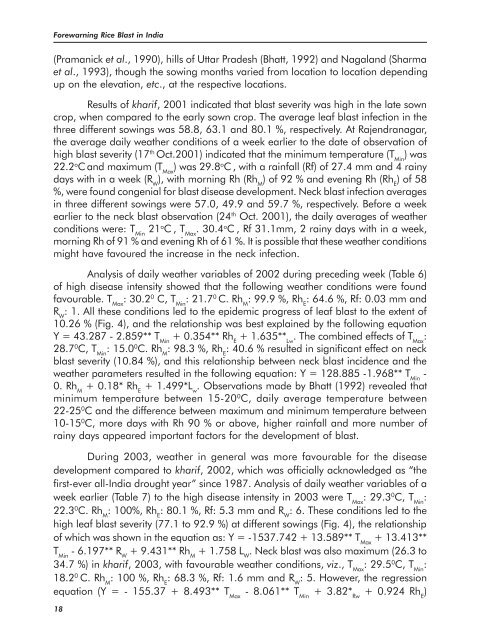Forewarning Rice Blast in India
Forewarning Rice Blast in India
Forewarning Rice Blast in India
Create successful ePaper yourself
Turn your PDF publications into a flip-book with our unique Google optimized e-Paper software.
<strong>Forewarn<strong>in</strong>g</strong> <strong>Rice</strong> <strong>Blast</strong> <strong>in</strong> <strong>India</strong><br />
(Pramanick et al., 1990), hills of Uttar Pradesh (Bhatt, 1992) and Nagaland (Sharma<br />
et al., 1993), though the sow<strong>in</strong>g months varied from location to location depend<strong>in</strong>g<br />
up on the elevation, etc., at the respective locations.<br />
Results of kharif, 2001 <strong>in</strong>dicated that blast severity was high <strong>in</strong> the late sown<br />
crop, when compared to the early sown crop. The average leaf blast <strong>in</strong>fection <strong>in</strong> the<br />
three different sow<strong>in</strong>gs was 58.8, 63.1 and 80.1 %, respectively. At Rajendranagar,<br />
the average daily weather conditions of a week earlier to the date of observation of<br />
high blast severity (17 th Oct.2001) <strong>in</strong>dicated that the m<strong>in</strong>imum temperature (T M<strong>in</strong> ) was<br />
22.2 o C and maximum (T Max ) was 29.8 o C , with a ra<strong>in</strong>fall (Rf) of 27.4 mm and 4 ra<strong>in</strong>y<br />
days with <strong>in</strong> a week (R W ), with morn<strong>in</strong>g Rh (Rh M ) of 92 % and even<strong>in</strong>g Rh (Rh E ) of 58<br />
%, were found congenial for blast disease development. Neck blast <strong>in</strong>fection averages<br />
<strong>in</strong> three different sow<strong>in</strong>gs were 57.0, 49.9 and 59.7 %, respectively. Before a week<br />
earlier to the neck blast observation (24 th Oct. 2001), the daily averages of weather<br />
conditions were: T M<strong>in</strong> 21 o C , T Max . 30.4 o C , Rf 31.1mm, 2 ra<strong>in</strong>y days with <strong>in</strong> a week,<br />
morn<strong>in</strong>g Rh of 91 % and even<strong>in</strong>g Rh of 61 %. It is possible that these weather conditions<br />
might have favoured the <strong>in</strong>crease <strong>in</strong> the neck <strong>in</strong>fection.<br />
Analysis of daily weather variables of 2002 dur<strong>in</strong>g preced<strong>in</strong>g week (Table 6)<br />
of high disease <strong>in</strong>tensity showed that the follow<strong>in</strong>g weather conditions were found<br />
favourable. T Max : 30.2 0 C, T M<strong>in</strong> : 21.7 0 C. Rh M : 99.9 %, Rh E : 64.6 %, Rf: 0.03 mm and<br />
R W : 1. All these conditions led to the epidemic progress of leaf blast to the extent of<br />
10.26 % (Fig. 4), and the relationship was best expla<strong>in</strong>ed by the follow<strong>in</strong>g equation<br />
Y = 43.287 - 2.859** T M<strong>in</strong> + 0.354** Rh E + 1.635** Lw . The comb<strong>in</strong>ed effects of T Max :<br />
28.7 0 C, T M<strong>in</strong> : 15.0 0 C. Rh M : 98.3 %, Rh E : 40.6 % resulted <strong>in</strong> significant effect on neck<br />
blast severity (10.84 %), and this relationship between neck blast <strong>in</strong>cidence and the<br />
weather parameters resulted <strong>in</strong> the follow<strong>in</strong>g equation: Y = 128.885 -1.968** T M<strong>in</strong> -<br />
0. Rh M + 0.18* Rh E + 1.499*L w . Observations made by Bhatt (1992) revealed that<br />
m<strong>in</strong>imum temperature between 15-20 0 C, daily average temperature between<br />
22-25 0 C and the difference between maximum and m<strong>in</strong>imum temperature between<br />
10-15 0 C, more days with Rh 90 % or above, higher ra<strong>in</strong>fall and more number of<br />
ra<strong>in</strong>y days appeared important factors for the development of blast.<br />
Dur<strong>in</strong>g 2003, weather <strong>in</strong> general was more favourable for the disease<br />
development compared to kharif, 2002, which was officially acknowledged as “the<br />
first-ever all-<strong>India</strong> drought year” s<strong>in</strong>ce 1987. Analysis of daily weather variables of a<br />
week earlier (Table 7) to the high disease <strong>in</strong>tensity <strong>in</strong> 2003 were T Max : 29.3 0 C, T M<strong>in</strong> :<br />
22.3 0 C. Rh M : 100%, Rh E : 80.1 %, Rf: 5.3 mm and R W : 6. These conditions led to the<br />
high leaf blast severity (77.1 to 92.9 %) at different sow<strong>in</strong>gs (Fig. 4), the relationship<br />
of which was shown <strong>in</strong> the equation as: Y = -1537.742 + 13.589** T Max + 13.413**<br />
T M<strong>in</strong> - 6.197** R W + 9.431** Rh M + 1.758 L W . Neck blast was also maximum (26.3 to<br />
34.7 %) <strong>in</strong> kharif, 2003, with favourable weather conditions, viz., T Max : 29.5 0 C, T M<strong>in</strong> :<br />
18.2 0 C. Rh M : 100 %, Rh E : 68.3 %, Rf: 1.6 mm and R W : 5. However, the regression<br />
equation (Y = - 155.37 + 8.493** T Max - 8.061** T M<strong>in</strong> + 3.82* Rw + 0.924 Rh E )<br />
18











